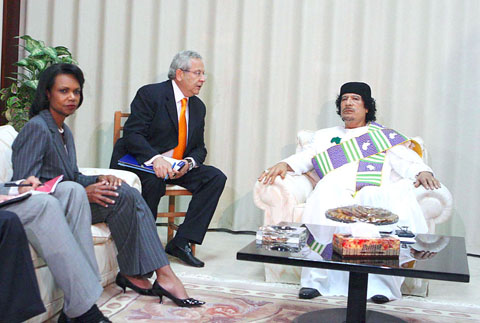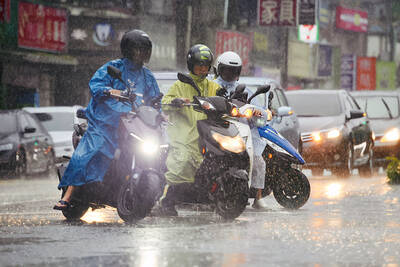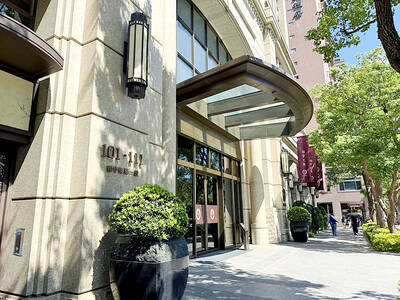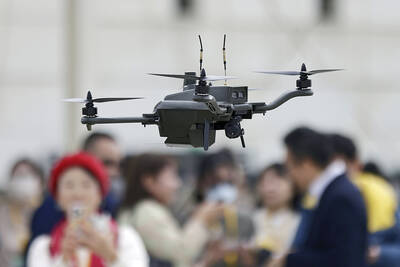The US and Libya sealed a historic turnaround after decades of terrorist killings, US retaliation, suspicion and insults with US Secretary of State Condoleezza Rice’s peacemaking visit with Muammar Qaddafi, Libya’s mercurial strongman.
“The relationship has been moving in a good direction for a number of years now and I think tonight does mark a new phase,” Rice said on Friday after a traditional Ramadan dinner — the evening meal that breaks the day’s fast during the Muslim holy month — at Qaddafi’s official Bab el-Azizia residence. It is the same compound hit by US airstrikes in 1986 in retaliation for a deadly Libyan-linked terrorist attack in Germany. The attack killed Qaddafi’s baby daughter.
“We did talk about learning from the lessons of the past,” Rice said. “We talked about the importance of moving forward. The United States, I’ve said many times, doesn’t have any permanent enemies.”

PHOTO: EPA
Rice is the highest-ranking US official to visit Libya in a half-century. The US considers Qaddafi rehabilitated since the days when former US President Ronald Reagan called him the “mad dog of the Middle East,” because of the Libyan’s surprise decision in 2003 to renounce terrorism and give up weapons of mass destruction. His government has also agreed to resolve legal claims from the bombing of Pan Am Flight 103 and other alleged terror attacks that bore Libyan fingerprints.
“Libya has changed, America has changed, the world has changed,” Foreign Minister Abdel-Rahman Shalgam said after a meeting with Rice. “Forget the past.”
Qaddafi welcomed Rice in a room redolent of incense. Wearing flowing white robes, his trademark fez and a green pin of Africa, Qaddafi bowed slightly and put his right hand over his heart in a traditional Arab greeting. The two did not shake hands, but Qaddafi did shake the hands of Rice’s male aides.
“We’re off to a good start,” Rice said later. “It is only a start, but I think, after many, many years, it’s a very good thing that the United States and Libya are establishing a way forward.”
The US withdrew its ambassador from Libya in 1972 after Qaddafi renounced agreements with the West and vilified the US in speeches and public statements. Washington cut off diplomatic relations with Libya after a mob sacked and burned the US embassy in 1979.
Qaddafi is known for often unpredictable behavior and has cultivated images as both an Arab potentate and African monarch since taking power in a 1969 coup. In a televised address to the nation this week he said he considers the US neither a friend nor an enemy.
Rice is the first US secretary of state to visit Libya since John Foster Dulles in 1953 and the highest-ranking US official to visit since then-US vice president Richard Nixon in 1957.
Libya has agreed to pay compensation to the families of victims of the 1988 Pan Am bombing over Lockerbie, Scotland, and those of a 1986 attack on a disco in Berlin. The disco attack killed two US servicemen and drew Reagan’s order to attack Libyan targets, including Qaddafi ‘s residence.
Rice was spending only a few hours in Tripoli, an ancient city fronting the Mediterranean Sea and backing to the North African desert, but took time to visit the offices that serve as the US embassy in Libya.
Plans to send a full-fledged ambassador and build a new embassy are hung up in US congress over concern that Libya has not fulfilled its promises to compensate terror victims.

The combined effect of the monsoon, the outer rim of Typhoon Fengshen and a low-pressure system is expected to bring significant rainfall this week to various parts of the nation, the Central Weather Administration (CWA) said. The heaviest rain is expected to occur today and tomorrow, with torrential rain expected in Keelung’s north coast, Yilan and the mountainous regions of Taipei and New Taipei City, the CWA said. Rivers could rise rapidly, and residents should stay away from riverbanks and avoid going to the mountains or engaging in water activities, it said. Scattered showers are expected today in central and

COOPERATION: Taiwan is aligning closely with US strategic objectives on various matters, including China’s rare earths restrictions, the Ministry of Foreign Affairs said Taiwan could deal with China’s tightened export controls on rare earth metals by turning to “urban mining,” a researcher said yesterday. Rare earth metals, which are used in semiconductors and other electronic components, could be recovered from industrial or electronic waste to reduce reliance on imports, National Cheng Kung University Department of Resources Engineering professor Lee Cheng-han (李政翰) said. Despite their name, rare earth elements are not actually rare — their abundance in the Earth’s crust is relatively high, but they are dispersed, making extraction and refining energy-intensive and environmentally damaging, he said, adding that many countries have opted to

FORCED LABOR: A US court listed three Taiwanese and nine firms based in Taiwan in its indictment, with eight of the companies registered at the same address Nine companies registered in Taiwan, as well as three Taiwanese, on Tuesday were named by the US Department of the Treasury’s Office of Foreign Assets Control (OFAC) as Specially Designated Nationals (SDNs) as a result of a US federal court indictment. The indictment unsealed at the federal court in Brooklyn, New York, said that Chen Zhi (陳志), a dual Cambodian-British national, is being indicted for fraud conspiracy, money laundering and overseeing Prince Holding Group’s forced-labor scam camps in Cambodia. At its peak, the company allegedly made US$30 million per day, court documents showed. The US government has seized Chen’s noncustodial wallet, which contains

SUPPLY CHAIN: Taiwan’s advantages in the drone industry include rapid production capacity that is independent of Chinese-made parts, the economic ministry said The Executive Yuan yesterday approved plans to invest NT$44.2 billion (US$1.44 billion) into domestic production of uncrewed aerial vehicles over the next six years, bringing Taiwan’s output value to more than NT$40 billion by 2030 and making the nation Asia’s democratic hub for the drone supply chain. The proposed budget has NT$33.8 billion in new allocations and NT$10.43 billion in existing funds, the Ministry of Economic Affairs said. Under the new development program, the public sector would purchase nearly 100,000 drones, of which 50,898 would be for civil and government use, while 48,750 would be for national defense, it said. The Ministry of